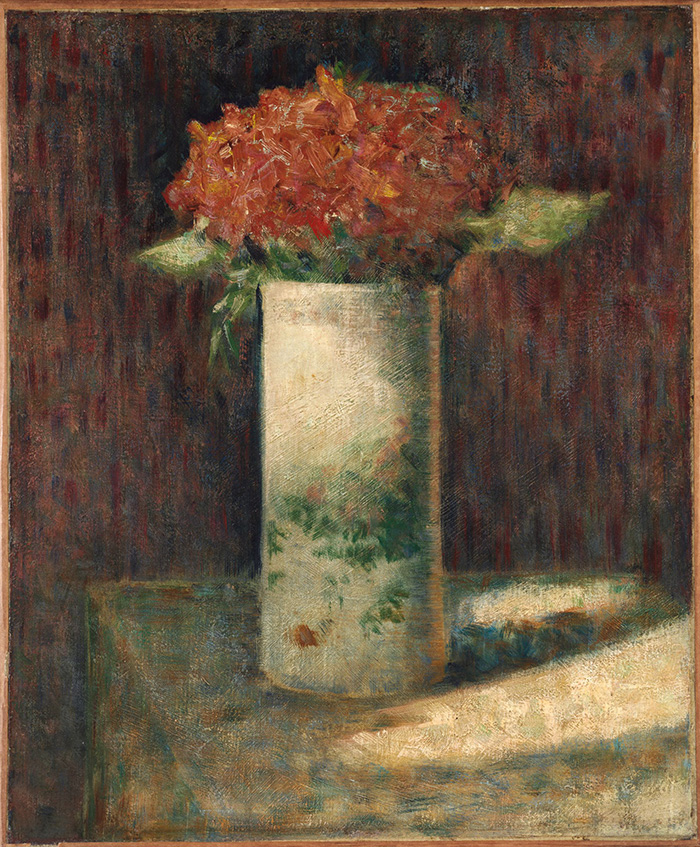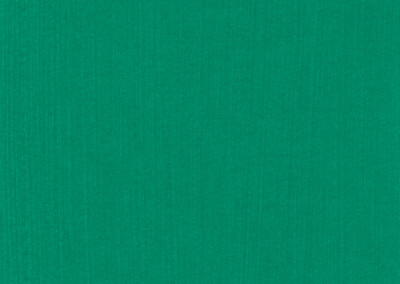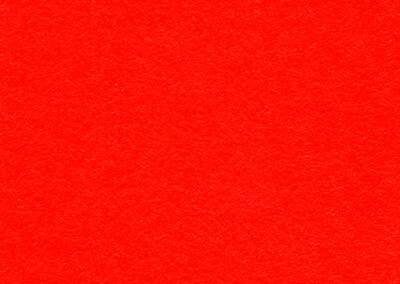Georges Seurat, Vase of Flowers
ca 1879-81Georges Seurat, Vase of Flowers
ca 1879-81Paintings sorted by Historical period | Painter | Subject matter | Pigments used
Overview
Medium: Oil
Support: Canvas
Size: 46.3 x 38.5 cm
Art period: Post-Impressionism
Harvard Art Museums (Fogg Art Museum)
Object number: 1974.100
Text by Dina Anchin
“Overall, the painted structure of Vase of Flowers is complex and shows just how much forethought and planning Seurat invested in a painting. One facet of his layering system in Vase of Flowers is prominent brushwork throughout most of the composition that has no correlation to the painted objects within the composition. Cross-sections reveal that this texture is not in the ground, but rather in between paint layers: it is part of a layering system that involved abrading the top paint layers to reveal certain colors side by side. Cross-sections, SEM-EDS analysis and mock-ups helped to better understand this process. Furthermore, compositional changes and reworking of the composition visible in the X-ray may indicate Vase of Flowers was only a study, never considered a finished work. Seurat was a meticulous artist, using materials and methods of paint application as a means of integrating theoretical concepts into his paintings. In Vase of Flowers, he was experimenting with a number of different techniques, though there is reason and theory behind every choice. Vase of Flowers can be viewed as a stepping-stone in Seurat’s career, as he works toward Pointillism.”
References
(1) Anchin, D., Website of the American Institute for Conservation
Pigments
Pigment Analysis
This pigment analysis is based on the unpublished thesis of Dina Anchin (1). The thesis describes first the complex layer structure of this painting.
“Rather than complex paint mixtures, Seurat superimposed many thin transparent or semi-transparent paint layers. In addition, cross-sections show that many of the layers were applied wet-in-wet, such as the yellow- green layers that that compose the green leaves in cross-section 2. There is however, a distinct boundary in the same cross-section between the green layers and blue/red layers, indicating Seurat allowed enough time to pass for the green paint layers to dry and a skin to form before applying the violet shades of the background. One of the distinguishing characteristics of Seurat’s layering system in Vase of Flowers is the strong prominent brushwork throughout most of the composition. Visually, this is most obvious in the center of the painting (see Figure 35 and 36). This brushwork has no correlation to the painted objects within the composition and from cross-sections, it is clear this layer is not a ground layer. As seen in cross-section 2, Figure 37, this brushworking is found in-between other paint layers, the small patches of white paint between the greenish and red layers (indicated by the yellow arrows). This brushworking was used as part of Seurat’s technique of sanding or scraping away the top paint layers when the paint was dry or stiff enough to create distinct edges. Full examination of the painted surface under magnification helped to prove that this feature was not due to overcleaning; rather, Seurat used a strategic and complex layering system on top of the brushwork, to intentionally reveal layers below. Figures 38 and 39 help to illustrate the layering system used by Seurat over the prominent brushwork, as well as the strategic abrasion of layers.” (1)
The above-mentioned figures can be found in the pdf-document of the thesis by Dina Anchin. The pigments for analysis have been taken from four small areas in which the paint was either flaking or cracked. The following pigments have been identified in these areas: Blues: cobalt blue and artificial ultramarine Greens: viridian. Reds: vermilion, madder lake, and carmine lake – probably cochineal (2). Yellows: Indian yellow.
References
(1 a) Dina Anchin, “Refining Style: Technical Investigation of an Early Work by Georges Pierre Seurat in the Maurice Wertheim Collection” (thesis (certificate in conservation), Straus Center for Conservation and Technical Studies, 2013), Unpublished. (1 b) Dina Anchin, Refining Style: Technical Investigation of an Early Work by Georges Pierre Seurat in the Maurice Wertheim Collection, The AIC Paintings Specialty Group Postprints, Vol. 27 (2014), p. 103-114.
(2) Kirby, J., Stonor, K., Roy, A., Burnstock, A., Grout, R., White, R. ‘Seurat’s Painting Practice: Theory, Development and Technology‘. National Gallery Technical Bulletin Vol 24, pp 4–37.
Pigments Used in This Painting
Resources
Videos
Video: 'Georges Seurat, A Collection of 135 Works' by LearnFromMasters
Publications and Websites
Publications
(1 a) Dina Anchin, “Refining Style: Technical Investigation of an Early Work by Georges Pierre Seurat in the Maurice Wertheim Collection” (thesis (certificate in conservation), Straus Center for Conservation and Technical Studies, 2013), Unpublished. (1 b) Dina Anchin, Refining Style: Technical Investigation of an Early Work by Georges Pierre Seurat in the Maurice Wertheim Collection, The AIC Paintings Specialty Group Postprints, Vol. 27 (2014), p. 103-114.
(2) Herbert, Robert L., Françoise Cachin, Anne Distel, Susan Alyson Stein, and G. T. Georges Seurat, 1859–1891. The Metropolitan Museum of Art, 1991.
(3) G. Seurat, Vase of Flowers, the website of the Harvard Art Museum.
(4) Kirby, J., Stonor, K., Roy, A., Burnstock, A., Grout, R., White, R. ‘Seurat’s Painting Practice: Theory, Development and Technology’. National Gallery Technical Bulletin Vol 24, pp 4–37.







